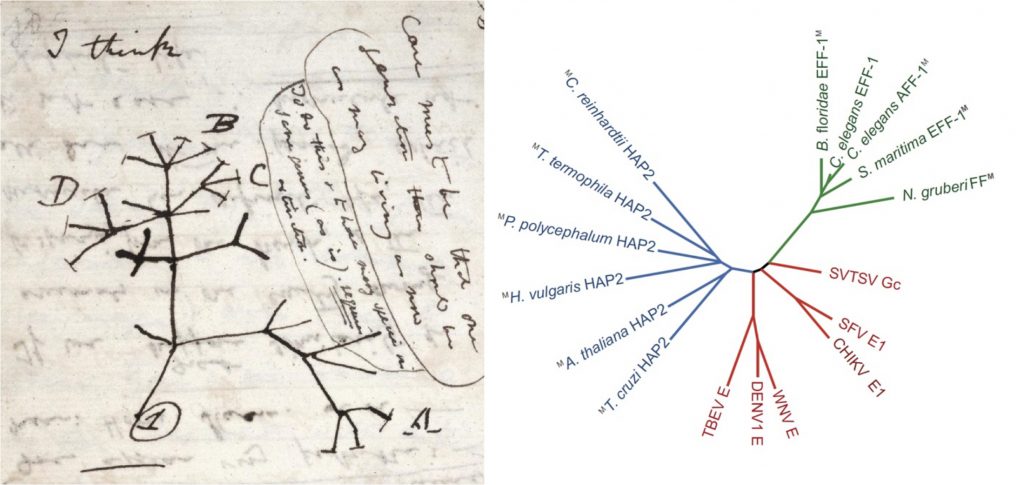Happy 210th birthday Mr. Charles Darwin!
From the origin of species to the origin of sexual reproduction
Yael Iosilevskii and Benjamin Podbilewicz, Faculty of Biology, Technion
In 1831 Captain Robert FitzRoy commissioned His Majesty’s Ship ‘Beagle’ and set out on an expedition, accompanied by “Mr. Charles Darwin…a young man of promising ability, extremely fond of geology, and indeed of all branches of natural history” [1]. This journey, would give rise to the most important book ever written in life sciences.
In his book, “On the origin of species by means of natural selection, or the preservation of favoured races in the struggle for life,” published in 1859, Darwin claimed that evolution by natural selection was one of the main forces influencing the variation in living organisms. For the first time in history, this book depicted evolution in the form of a (family) tree wherein various species which exist today are the result of the branching out of an extinct ancestor [2]. Such evolution is evident in language development [3], disease outbreaks [4], and in the formation of new plant and animal species [5].
How is a new species of a living organism created? First, we must define what is a species. Animals of different species cannot sexually reproduce (to bear fertile offspring). Changes in the genetic composition or the environment from one generation to the next may create a situation whereby two populations become distinct enough so as to not be able to reproduce between them – thus, a new species is created from an existing one. Over time, these differences become greater and the species become more divergent. Many mechanisms can contribute to this separation, but a significant factor is the requirement for a perfect match of the special cells responsible for reproduction, the gametes (e.g. sperm and egg) [6]. In general, only same-species gametes will fuse to form a zygote (or fertilized egg), from which an entire new organism would develop.
This seemingly trivial first step in sexual reproduction is in fact one of the greatest mysteries of all time: Two cells will not fuse spontaneously; special proteins called fusogens must mediate this, and the fusogens mediating sperm – egg fusion in vertebrates, including humans, are unknown.
We do know the identity of fusogens responsible for fusion of gametes in other sexually reproducing species: flowering plants and the malaria parasite use proteins called “HAP2” [7], and some viruses use “class II fusion proteins” to merge into the cell they infect. Additionally, in the worm C. elegans, one third of all cells fuse to sculpt organs using proteins called “EFF-1” [8]. Remarkably, these proteins, from plants, parasites, viruses, and worms, look almost identical, and can interact to cause different cells to fuse in a petri dish [7].
The similarity of structure between EFF-1, HAP2 and viral class II fusion proteins enables us to trace back and speculate that there was once a common ancestor to these fusion proteins, from which multiple families diverged [9]. Were sexual fusogens ‘stolen’ by viruses from the ancient hosts, or were they a viral mechanism adopted by ancient organisms to facilitate sexual reproduction? We are still not sure.
Figure: Trees depicting evolution. The first known evolutionary tree drawn by Darwin in 1837 (left) [10] and a tree showing the structural relationships between fusogens of the family named fusexins (right). Viral class II proteins (red); somatic fusogens (green); sexual fusogens (blue) [7].
As research develops, we will be able to identify and describe new fusogens and place them accordingly into an evolutionary tree. In Darwin’s words, “Of the many twigs which flourished when the tree was a mere bush, only two or three, now grown into great branches, yet survive and bear the other branches; so with the species which lived during long-past geological periods, very few have left living and modified descendants.” [2] As such, Darwin’s original ideas have continued to evolve with us over the past 160 years, and will surely continue to do so.
References:
- FitzRoy, R., (1839). The narrative of the voyages of H.M. Ships Adventure and Beagle. London: Colburn [1st ed.] Proceedings of the second expedition, 1831-36. pp. 18-19. http://darwin-online.org.uk/content/frameset?pageseq=1&itemID=F10.2&viewtype=text
- Darwin, C. (1859). On the origin of species by means of natural selection, or the preservation of favoured races in the struggle for life. London: Murray. [1st ed.] pp.3-6 http://darwin-online.org.uk/content/frameset?itemID=F373&viewtype=text&pageseq=1
- Corballis, M. C. (2017). Language evolution: a changing perspective. Trends in Cognitive Sciences, 21(4), 229-236. https://www.sciencedirect.com/science/article/pii/S1364661317300190?via%3Dihub
- Su, S., Bi, Y., Wong, G., Gray, G. C., Gao, G. F., & Li, S. (2015). Epidemiology, Evolution, and Recent Outbreaks of Avian Influenza Virus in China. Journal of virology, 89(17), 8671-6. https://jvi.asm.org/content/89/17/8671
- Shapiro, B. J., Leducq, J. B., & Mallet, J. (2016). What Is Speciation?. PLoS genetics, 12(3), e1005860. https://journals.plos.org/plosgenetics/article?id=10.1371/journal.pgen.1005860
- Springate, L., & Frasier, T. R. (2017). Gamete compatibility genes in mammals: candidates, applications and a potential path forward. Royal Society open science, 4(8), 170577. https://royalsocietypublishing.org/doi/10.1098/rsos.170577
- Valansi, C., Moi, D., Leikina, E., Matveev, E., Graña, M., Chernomordik, L. V., Romero, H., Aguilar, P. S., & Podbilewicz, B. (2017). Arabidopsis HAP2/GCS1 is a gamete fusion protein homologous to somatic and viral fusogens. J Cell Biol, 216(3), 571-581. https://www.ncbi.nlm.nih.gov/pmc/articles/PMC5350521/
- Mohler, W. A., Shemer, G., del Campo, J. J., Valansi, C., Opoku-Serebuoh, E., Scranton, V., Assaf, N., White, J.G., & Podbilewicz, B. (2002). The type I membrane protein EFF-1 is essential for developmental cell fusion. Developmental cell, 2(3), 355-362. https://www.sciencedirect.com/science/article/pii/S1534580702001296?via%3Dihub
- Hernández, J. M., & Podbilewicz, B. (2017). The hallmarks of cell-cell fusion. Development, 144(24), 4481-4495. http://dev.biologists.org/content/144/24/4481
- Darwin, C. Notebook B: [Transmutation of species (1837-1838)]. ‘commenced. . . July 1837’. pp.36. http://darwin-online.org.uk/manuscripts.html(DAR121)



